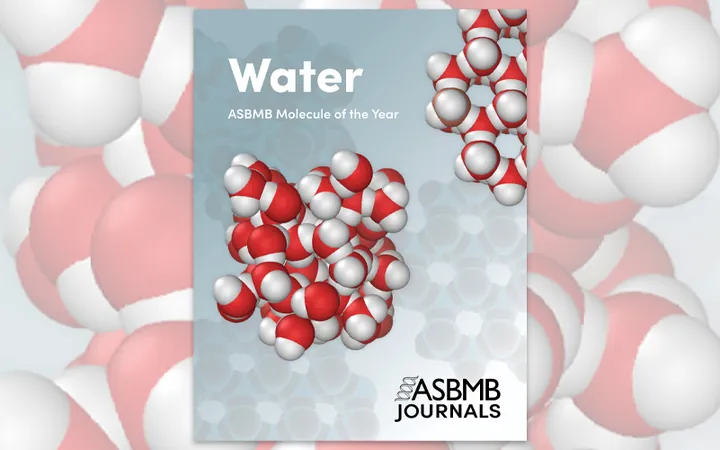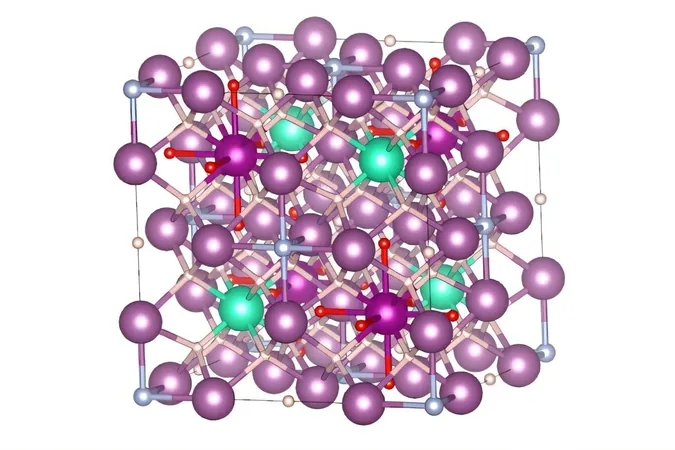
Dive into the Depths: Celebrating Water in Groundbreaking ASBMB Research!
2024-10-30
Author: Yu
Introduction
The American Society for Biochemistry and Molecular Biology (ASBMB) has declared water the “Molecule of the Year” for 2024, sparking a wave of excitement and exploration within the scientific community. This initiative invited experts to share their insights, leading to the creation of a captivating virtual issue showcasing innovative research from ASBMB’s esteemed journals.
Virtual Collection Overview
Under the guidance of Publications Director Isabel Casas and Assistant Publications Director Chengmin Jiang, this virtual collection features 12 gold open-access articles that delve into the critical role water plays in biochemical processes, drawing from three years of cutting-edge studies published in the Journal of Biological Chemistry, the Journal of Lipid Research, and Molecular & Cellular Proteomics.
Highlighted Research
Among the highlights are fascinating studies unraveling the mysteries of water's interaction with macromolecules, including a groundbreaking analysis of a toxic RNA structure linked to diseases. Researchers utilized cryo-electron microscopy to illuminate how water is oxidized to produce oxygen in the key photosynthesis enzyme, photosystem II (PSII). A pivotal finding demonstrated the presence of a water bridge within a mismatched base pair of RNA, shedding light on myotonic dystrophy type 1, a condition stemming from genetic mutations.
Photosystem II Studies
The issue further explores PSII from various perspectives; one study examined how cyanobacteria adapt to lower light conditions for efficient water oxidation. Another revealed that mutating a crucial residue disrupts essential water channels, emphasizing water's structural significance.
Aquaporins and Water Transport
A notable section addresses the mechanisms of water transport into cells. Researchers discovered that a specific plant aquaporin—a protein vital for membrane solute transport—can also transport sucrose and lactose. Such findings are monumental, potentially impacting global food production and plant growth strategies. Additionally, understanding aquaporin structures has illuminated the functionality of a formate-nitrate transporter.
Cell Membrane Studies
The impact of cell damage on water permeability was also scrutinized. In a groundbreaking study, it was found that lipid peroxidation leads to water pore formation in cell membranes, a process that antioxidant flavonoids can mitigate. Similarly, the dynamics of water influx in T cells were observed, revealing a rapid intake of extracellular water prior to cell division, a shift away from the slower absorption typically associated with glycolytic processes.
Innovative Methodologies
Innovative methodologies employing water, particularly deuterium, are highlighted for their essential roles in mass spectrometry. Researchers compared heavy water with stable isotope-labeled amino acids to measure protein turnover rates, while another investigation tracked cholesterol's biosynthetic origins in the retina and brain using isotopic labeling.
Hormone Research and Cognitive Function
Furthermore, water’s unique phase separation properties have been harnessed to improve hormone extraction techniques, paving the way for advancements in steroid research. The application of the Morris water maze test revealed insights into cognitive functions in mice, particularly how certain compounds impact neurodegenerative disease markers.
Conclusion
As the collection culminates, it emphasizes the multifaceted roles that water plays in the realms of biochemistry and molecular biology. The implications of these findings stretch beyond academia, promising potential advancements in health and agriculture. Dive deeper into the multifarious significance of water through this new ASBMB Journals virtual issue and discover how this fundamental molecule continues to shape scientific understanding and innovation. Don't miss out on unlocking the secrets that water holds for our future!




 Brasil (PT)
Brasil (PT)
 Canada (EN)
Canada (EN)
 Chile (ES)
Chile (ES)
 España (ES)
España (ES)
 France (FR)
France (FR)
 Hong Kong (EN)
Hong Kong (EN)
 Italia (IT)
Italia (IT)
 日本 (JA)
日本 (JA)
 Magyarország (HU)
Magyarország (HU)
 Norge (NO)
Norge (NO)
 Polska (PL)
Polska (PL)
 Schweiz (DE)
Schweiz (DE)
 Singapore (EN)
Singapore (EN)
 Sverige (SV)
Sverige (SV)
 Suomi (FI)
Suomi (FI)
 Türkiye (TR)
Türkiye (TR)